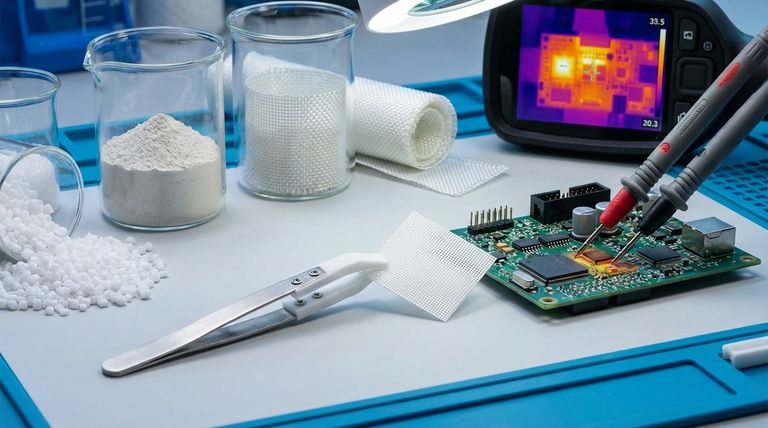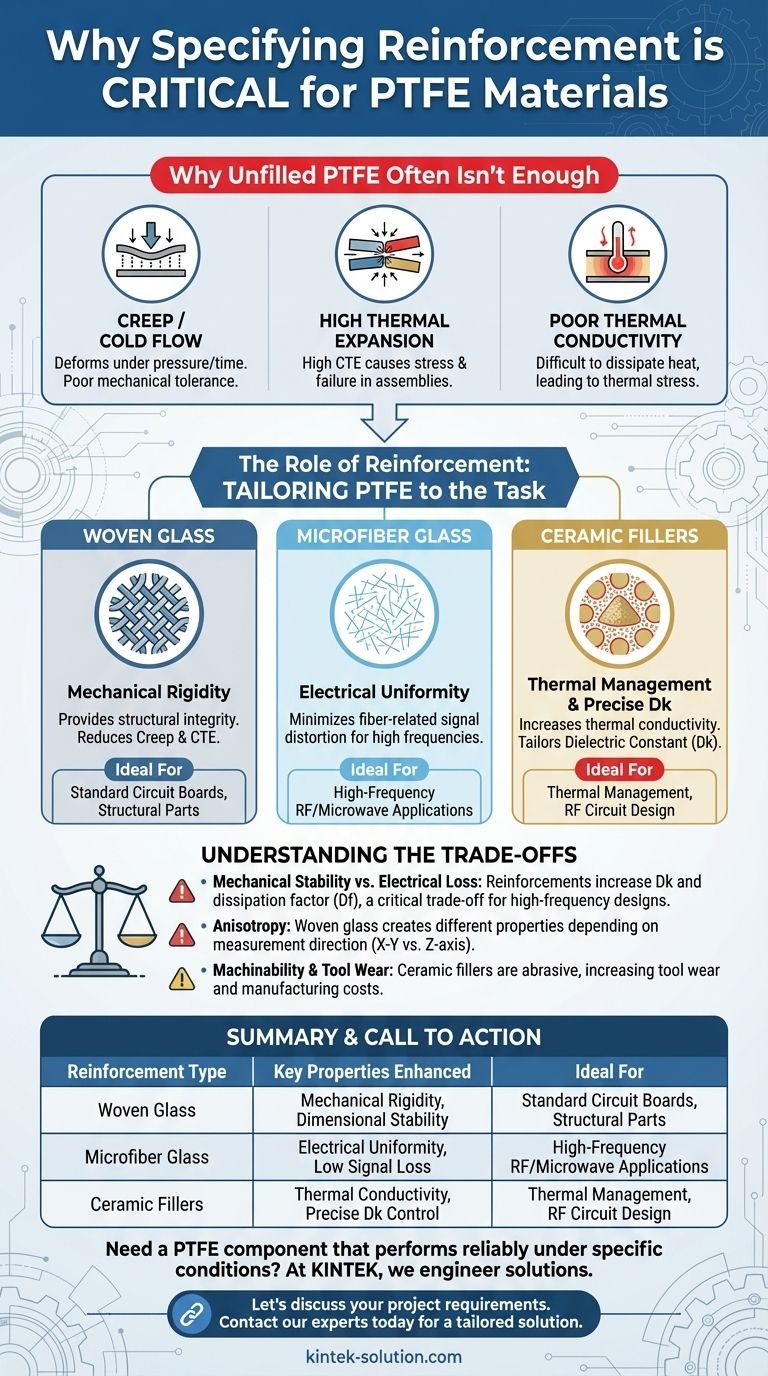Specifying the reinforcement in PTFE is critical because the filler material fundamentally alters the material's electrical, mechanical, and thermal properties. Without this specification, you relinquish control over these core characteristics. The choice may default to what a fabrication house has in stock, leading to a final product that fails to meet your design's reliability and functionality standards.
The choice of a PTFE reinforcement is not merely a material selection; it is a fundamental design decision. The filler dictates the component's stability, reliability, and ultimate performance, and leaving this choice to chance is a significant engineering risk.

Why Unfilled PTFE Often Isn't Enough
Pure Polytetrafluoroethylene (PTFE) is an exceptional material, known for its extremely low electrical loss and chemical inertness. However, its inherent properties create significant limitations in many demanding applications.
The Problem of "Creep"
Pure PTFE is mechanically soft. Under pressure and over time, it can deform or "creep," a phenomenon also known as cold flow. This is unacceptable in applications requiring tight mechanical tolerances.
High Thermal Expansion
PTFE expands and contracts significantly with temperature changes. This high coefficient of thermal expansion (CTE) can cause stress and failure in assemblies, especially when bonded to materials with a lower CTE, like copper in a printed circuit board.
Poor Thermal Conductivity
The material is also a poor thermal conductor, making it difficult to dissipate heat away from active components. This can lead to thermal stress and reduced component lifespan.
The Role of Reinforcement: Tailoring PTFE to the Task
Reinforcements are added to the PTFE matrix to counteract its weaknesses and enhance specific properties required by the application. The choice of reinforcement is a deliberate engineering act.
Woven Glass: The Standard for Rigidity
Adding woven glass fabric is the most common method for improving PTFE's mechanical stability. It dramatically reduces creep and lowers the CTE, providing the dimensional stability needed for most circuit boards and structural components.
Microfiber Glass: The Choice for Electrical Purity
Instead of a woven fabric, short glass microfibers are randomly dispersed throughout the PTFE. This creates a more uniform material, electrically speaking. It minimizes the slight variations in dielectric constant (Dk) that can be caused by the pattern of a woven fabric, which is critical for very high-frequency applications.
Ceramic Fillers: The Key to Thermal Management
Ceramic powders are blended into the PTFE to achieve two primary goals. First, they significantly increase the material's thermal conductivity, helping to draw heat away from components. Second, they can be used to precisely tailor the material's dielectric constant, which is essential for RF and microwave circuit design.
Understanding the Trade-offs
Adding a filler material to PTFE is always a balance. Improving one property often comes at the expense of another.
The Cost of Mechanical Stability
Glass and ceramic have a higher dielectric constant and are more electrically lossy than pure PTFE. Therefore, adding them as reinforcement will increase the overall Dk and dissipation factor (Df) of the composite material. This is a critical trade-off for high-frequency designs where minimizing loss is paramount.
The Anisotropy Factor
Woven glass creates a material that is anisotropic, meaning its properties are different depending on the direction of measurement. The material's characteristics in the X-Y plane (along the weave) will differ from the Z-axis (through the weave), which must be accounted for in advanced circuit modeling.
Machinability and Tool Wear
Materials with ceramic fillers are significantly more abrasive than pure or glass-reinforced PTFE. This increases tool wear during fabrication processes like drilling and milling, which can impact manufacturing costs and precision.
Making the Right Choice for Your Application
By specifying the reinforcement, you are directly controlling the final performance characteristics of your component. Your choice should be dictated by your primary design goal.
- If your primary focus is mechanical stability and cost-effectiveness: Woven glass reinforcement is the default choice for providing essential structural integrity.
- If your primary focus is pristine electrical performance at high frequencies: Microfiber glass reinforcement offers better electrical uniformity and minimizes fiber-related signal distortion.
- If your primary focus is thermal management or precise Dk control: Ceramic fillers are essential for dissipating heat and achieving specific target electrical properties.
Ultimately, proactively specifying your PTFE reinforcement transforms a simple material callout into a precise engineering instruction, ensuring your design performs exactly as intended.
Summary Table:
| Reinforcement Type | Key Properties Enhanced | Ideal For |
|---|---|---|
| Woven Glass | Mechanical Rigidity, Dimensional Stability | Standard Circuit Boards, Structural Parts |
| Microfiber Glass | Electrical Uniformity, Low Signal Loss | High-Frequency RF/Microwave Applications |
| Ceramic Fillers | Thermal Conductivity, Precise Dk Control | Thermal Management, RF Circuit Design |
Need a PTFE component that performs reliably under specific conditions?
At KINTEK, we don't just supply PTFE—we engineer solutions. By specifying your reinforcement requirements (glass, ceramic, or custom fillers), we ensure your seals, liners, and labware meet the exact electrical, mechanical, and thermal demands of your application in the semiconductor, medical, or industrial sectors.
We specialize in custom fabrication, from prototypes to high-volume orders, prioritizing precision to solve challenges like creep, thermal expansion, and signal loss.
Let's discuss your project requirements and material needs. Contact our experts today for a tailored solution.
Visual Guide

Related Products
- Custom PTFE Parts Manufacturer for Teflon Parts and PTFE Tweezers
- Custom PTFE Parts Manufacturer for Teflon Containers and Components
- Custom PTFE Teflon Balls for Advanced Industrial Applications
- Customizable PTFE Seals Filter Holders for Versatile Applications
- Custom PTFE Sleeves and Hollow Rods for Advanced Applications
People Also Ask
- What challenges arise when machining PTFE (Teflon)? Overcome Softness, Heat, and Instability
- What are the unique properties of PTFE? The 3 Pillars Driving Demand for High-Performance Parts
- What chemical processing applications involve PTFE-machined parts? Essential Components for Corrosive & High-Purity Systems
- What fabrication services are available for PTFE? Shearing, Stamping, Laser Cutting, Molding & Machining
- What finishing techniques are effective for machined Teflon parts? Achieve Functional Performance and Dimensional Stability



















